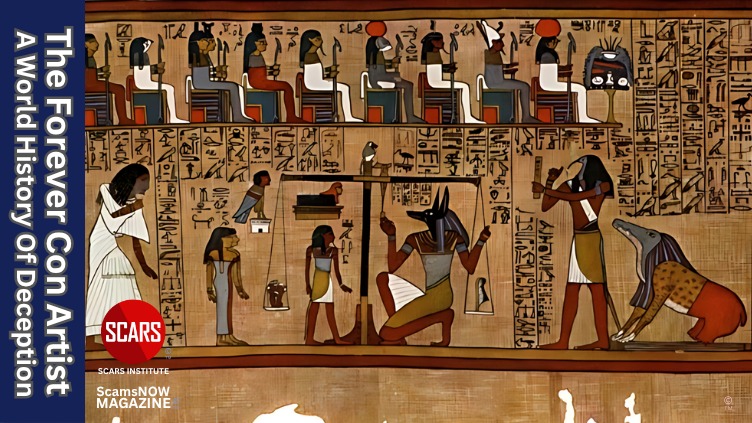
The Forever Con Artist – A World History Of Deception
A Journey Through Time – Unveiling the History of Con Men and Women – Understanding That Scams Have Always Been With Us!
Primary Category: Crimes & Criminals
Authors:
• Tim McGuinness, Ph.D., DFin, MCPO, MAnth – Anthropologist, Scientist, Polymath, Director of the Society of Citizens Against Relationship Scams Inc.
Author Biographies Below
About This Article
The deep history of deception and con artists show that cons are not new but persistent patterns that exploit predictable human biases, emotions, and social pressures. From ancient marketplaces to online platforms, scammers recycle the same tactics: false authority, false scarcity, engineered trust, and urgency. The account outlines how cognitive biases, fear, sympathy, and greed are targeted, how group dynamics are manipulated, and how technology merely amplifies old tricks. Practical defenses emerge: slow down, verify identities on a second channel, cross-check claims with public sources, seek one trusted opinion, and report attempts. The message centers on shared responsibility, steady habits, and open conversation that replace shame and secrecy with clarity, documentation, and support.

The Forever Con Artist – A Journey Through Time
Unveiling the History of Con Men and Women – Understanding That Scams Have Always Been With Us!
The Forever Con Artist has always been something that interested me as an Anthropologist, Archaeologist, and Historian. While working on archeological projects in Mesoamerica and South America, I have always been fascinated by each culture’s tricksters and how ubiquitous they always were. I have often wondered to what extent scammers or fraudsters, or tricksters were in the ancient world, because they are not a new phenomenon. Scams, fraud, and cons have always been with us – even animals are capable of pulling them off.
So much of the media is gushing about how these crimes are new and how scammers have only recently learned how to deceive their victims, when in reality the ability to deceive and be deceived is wired into our brains and DNA. It is nothing new. In fact, animals are also very good at deception and be deceived too, and interestingly they react in similar ways to humans.
To make this point, here is a brief history of scams, fraud, cons, and deceptions through time – what I call “the Forever Con.”
Author’s Note
This editorial is not about glorifying these criminals, nor is it to treat lightly the impact they have on their victims. Con men/women are murderers, they are rapists, they perpetrate some of the most unspeakable crimes for personal gain. But it is important to understand that this is not new, and in order to address the problem we cannot lose sight of the history of our civilization, both in what gives rise to it, and what controls and limits it. After all, without common honesty, integrity, and working for the common good, we would have no civilization at all. Scammers are a virus that we develop a civilization immunity against and then lose it from time to time. Right now, we have lost our immunity to this plague.
This article is not going to be all-inclusive, there is just to much to cover at one time, but this will give the reader an broad understanding to counter the media hype that this is all some new phenomenon.
The Psychology of Deception: Understanding the Art of the Con
Con artists are masters of human psychology, adept at manipulating emotions and exploiting vulnerabilities. They carefully study their targets, identifying their desires, fears, and weaknesses (vulnerabilities.) By playing on these emotions, con artists can gain the trust and cooperation of their victims, making them more susceptible to deception.
Con artists are not mere tricksters; they are masters of human psychology, adept at exploiting the inherent vulnerabilities that make us human. Their success hinges on their ability to understand and manipulate the cognitive, emotional, and social aspects of our being.
Cognitive Biases: The Achilles’ Heel of Human Judgment
Humans are susceptible to a range of cognitive biases, mental shortcuts that can lead to flawed decision-making. Con artists exploit these biases to their advantage, creating illusions and manipulating perceptions to deceive their victims.
-
- Confirmation bias: We tend to seek and favor information that confirms our existing beliefs, making us more susceptible to con artists who tailor their messages to align with our existing views.
- Scarcity bias: We place greater value on limited or scarce resources, making us more likely to fall for con artists who create a sense of urgency or exclusivity.
- Authority bias: We tend to trust and obey figures of authority, making us more susceptible to con artists who pose as experts or professionals.
Emotional Appeals: Tapping into the Human Condition (the Amygdala Strikes Again!)
Con artists understand the power of emotions and use them to manipulate their victims. They create emotional narratives that evoke feelings of fear, sympathy/empathy, or greed, clouding judgment and making individuals more susceptible to deception. [See our numerous articles on the Psychology of Scams to learn more about how this works.]
-
- Fear appeals: Con artists play on our fears of loss, financial ruin, or personal harm to compel us to act without rational thought.
- Sympathy appeals: Con artists evoke feelings of pity or compassion to gain our trust and extract money or favors.
- Greed appeals: Con artists exploit our desire for wealth, power, or status by offering promises of quick and easy gains.
Social Dynamics: The Power of Influence
Con artists are skilled social engineers, adept at manipulating social dynamics to their advantage. They create illusions of group consensus, exploit social hierarchies, and establish rapport to gain the trust and cooperation of their victims.
-
- Group consensus: Con artists create a false sense of agreement or approval, making individuals more likely to conform and accept their claims.
- Social hierarchies: Con artists exploit power dynamics, posing as insiders or experts to gain credibility and influence.
- Rapport building: Con artists establish a sense of connection and trust, making individuals more receptive to their suggestions.
The Art of Deception – A Short History of the Con!
The art of deception, as old as humanity itself, has existed in various forms throughout history. From the cunning tricksters of ancient civilizations to the sophisticated scammers of the modern era, con men and women have consistently exploited human vulnerabilities for personal gain.
We will explore the intriguing history of these masters of manipulation.
Ancient Egypt: The Cradle of Deception
In the cradle of civilization, ancient Egypt, con artists thrived amidst the bustling marketplaces and opulent temples. They employed a repertoire of tricks, from sleight of hand to elaborate schemes, to deceive unsuspecting individuals. One notorious scam involved selling fake amulets, promising protection from evil spirits but delivering nothing but empty hope.
Ancient Egypt, a land of towering pyramids, enigmatic hieroglyphs, and a rich cultural heritage, also harbored a thriving underbelly of deception. From the bustling marketplaces of Memphis to the opulent temples of Thebes, con artists thrived, exploiting the vulnerabilities of the populace for personal gain.
The Art of Misdirection
Egyptian con artists were masters of misdirection, employing sleight of hand, elaborate schemes, and a deep understanding of human psychology to deceive their unsuspecting victims. One common scam involved using mirrors to create false reflections of gold coins or precious stones, luring unsuspecting buyers into parting with their hard-earned money.
The Lure of Fake Relics
Religious fervor and the belief in the supernatural provided fertile ground for con artists in ancient Egypt. They capitalized on the deep-seated reverence for gods and goddesses, selling fake amulets, charms, and even mummified animals, promising protection, prosperity, or even immortality.
Fraudulent Oracles and Sham Healers
Oracles, believed to possess divine knowledge, were often targeted by con artists. Posing as oracles, they would deliver false prophecies or offer dubious remedies, exploiting the hopes and fears of those seeking guidance or healing.
The Papyrus Trap
Papyrus, the versatile writing material of ancient Egypt, was also a tool for deception. Con artists would create forged documents, such as legal contracts or love letters, to trick their victims into handing over money or property.
Rome: The Masterminds of Deception
As the Roman Empire rose to prominence, so did the sophistication of con artists. They skillfully navigated the complex social hierarchies and exploited the greed and ambition of the wealthy elite. One infamous scam involved selling fake land titles, leaving unsuspecting buyers with worthless plots.
As the Roman Empire grew into a vast and powerful civilization, so did the sophistication of its con artists. They thrived amidst the bustling cities, imperial courts, and far-flung provinces, exploiting the greed, ambition, and superstitions of the populace.
Masters of Manipulation
Roman con artists were masters of manipulation, adept at understanding and exploiting human psychology. They carefully studied their targets, identifying their desires, fears, and weaknesses. By playing on these emotions, con artists could gain the trust and cooperation of their victims, making them more susceptible to deception.
Elaborate Schemes and Calculated Risks
Roman con artists were not mere tricksters; they were orchestrators of elaborate schemes that required planning, cunning, and a calculated understanding of risk. They would carefully construct their narratives, using props, costumes, and false identities to create a convincing illusion of legitimacy.
Exploiting the Greed and Ambition of the Elite
The Roman Empire’s vast wealth and social hierarchies provided ample opportunities for con artists to exploit the greed and ambition of the wealthy elite. They would pose as wealthy merchants, offer lucrative investment opportunities, or sell forged land titles, enticing their targets with promises of quick riches and social advancement.
Capitalizing on Religious Superstitions
Religious beliefs and superstitions were deeply ingrained in Roman society, providing fertile ground for con artists. They would pose as priests, sell fake relics, or offer bogus prophecies, exploiting the hopes, fears, and desire for divine favor among the populace.
The Rise of Counterfeiting
As the Roman economy flourished, so did the art of counterfeiting. Con artists would create fake coins, jewelry, and even works of art, passing them off as genuine to unsuspecting buyers. These forgeries were often so skillfully crafted that they were difficult to detect, making them a lucrative source of illicit income.
Ancient Greece: A Crucible of Deception
Amidst the splendor of ancient Greece, where philosophy, art, and democracy flourished, a parallel world of deception thrived. Con artists, exploiting the vulnerabilities of human nature, found fertile ground in the bustling marketplaces, vibrant ports, and sacred temples. From elaborate schemes to subtle trickery, these masters of manipulation left an indelible mark on Greek history.
Masters in Understanding
As the Ancient Greek master philosophers were exploring our understanding of the universe, their darker side of this enlightenment was also expanding the fraudsters understanding of the human mind.
The Art of Misdirection
Greek con artists were masters of misdirection, employing sleight of hand, elaborate narratives, and a deep understanding of human psychology to deceive their unsuspecting victims. One common scam involved luring unsuspecting pilgrims on trips to see the gods, but along the way forcing them into parting with their hard-earned money.
Exploiting Human Vulnerabilities
Con artists in ancient Greece were adept at exploiting the range of human emotions and motivations. They preyed on fear, greed, ambition, and superstition, crafting schemes that appealed to the deepest desires and anxieties of their victims.
-
- Fear: False oracles, promising divine guidance, would exploit people’s fear of the unknown, offering prophecies and remedies that often led to misfortune.
- Greed: Cunning merchants would pose as traders selling exotic goods or promising lucrative investments, enticing individuals with the prospect of quick riches.
- Ambition: Politicians and generals would employ elaborate schemes to gain influence and power, manipulating the masses through propaganda and deception.
- Superstition: Con artists would capitalize on the widespread belief in supernatural powers, selling fake relics, charms, and amulets, promising protection, prosperity, or even immortality.
Notable Examples of Greek Deception
Ancient Greek history is replete with tales of infamous con artists who left a lasting impact. Here are a few notable examples:
-
- Hegestratos: A sea merchant who attempted to defraud his insurance company by sinking his own ship and claiming the cargo as lost at sea. His plan was foiled by his crew, who alerted the authorities.
- Phormio: A ship captain who repeatedly claimed his vessel had been damaged or sunk during voyages, only to have his claims exposed as fraudulent.
- Zenothemis: Another ship captain who attempted to defraud his insurance company by orchestrating a mock shipwreck, but his plan was thwarted when the supposedly sunken vessel was discovered intact.
China: The Masters of Misdirection
In the vast and diverse land of China, con artists developed a unique blend of trickery and psychological manipulation. They employed subtle cues and persuasive tactics to gain the trust of their victims before executing their schemes. One common scam involved posing as government officials, extorting money from unsuspecting merchants (the birth of the protection racket.)
China, a land steeped in rich traditions and intricate customs, has also harbored a long and enduring history of deception. From the bustling marketplaces of ancient dynasties to the modern metropolises of today, con artists have thrived, exploiting the vulnerabilities of the populace for personal profit.
Masters of Subterfuge and Subtlety
Chinese con artists are renowned for their mastery of subterfuge and subtlety. After all, what we think of today as stage magic originated in China. They employ a blend of misdirection, psychological manipulation, and sophisticated techniques to deceive their unsuspecting victims. Their schemes often rely on cultural nuances, social hierarchies, and deep-seated beliefs to create an illusion of legitimacy and trust.
Capitalizing on Cultural Norms and Superstitions
Chinese culture, with its emphasis on filial piety, respect for authority, and belief in the supernatural, has provided fertile ground for con artists to exploit. They pose as elders or officials, capitalize on reverence for ancestral traditions, or sell fake relics or charms, taking advantage of the populace’s desire for harmony, prosperity, and spiritual protection.
The Art of Counterfeiting and Forgery
Counterfeiting and forgery have long been a hallmark of Chinese con artistry. Skilled artisans have produced replicas of everything from precious metals and gemstones to artwork and ancient artifacts, deceiving collectors, merchants, and even emperors. The sophistication of these forgeries has often made them indistinguishable from the originals, highlighting the cunning and skill of Chinese con artists. At one time, there was a thriving market for dragon’s teeth – of course, they were fake, but belief was more powerful than caution.
The Rise of Modern Scams and Frauds
In the modern era, Chinese con artists have adapted their methods to keep pace with technological advancements and the complexities of modern society. They utilize sophisticated phishing scams, elaborate investment schemes, and online identity theft, exploiting the vulnerabilities of individuals who rely on digital technology for communication, transactions, and personal information management. In short, not much has changed, just the ways con artists reach their victims.
The Middle Ages: The Rise of Religious Scams
During the Middle Ages, religious fervor provided fertile ground for con artists. They exploited the deep-seated beliefs of the populace, posing as holy men or selling false relics to extract money from the faithful. Con artists, exploiting the deep-seated beliefs and anxieties of the populace, devised elaborate schemes and manipulated religious sentiments for personal advantage. One particularly notorious scam involved selling indulgences, promising remission of sins in exchange for hefty payments.
Fake Relics and Indulgences
The veneration of saints and relics played a significant role in medieval society. Con artists capitalized on this devotion by selling fake relics, claiming they possessed miraculous powers or offered protection from harm. They would forge documents authenticating the relics, creating elaborate narratives to enhance their authenticity. There was, and still is, a thriving business in the bones of saints and even wood splinters from Christ’s cross.
Indulgences, pardons for sins, were another avenue for deception. Con artists would falsely sell indulgences, promising remission of sins in exchange for payment. They would exploit the fear of purgatory and the desire for spiritual absolution to extract money from the faithful.
False Prophecies and Miracle Performances
Self-proclaimed prophets and miracle workers thrived in the Middle Ages. They would stage elaborate performances, claiming to have divine visions or perform miraculous healings. Their acts would attract large crowds, eager to witness divine intervention. The prophets would then collect offerings or sell amulets, exploiting the credulity of their followers. This is still being done to large audiences around the world today.
Exploitation of Pilgrimages
Pilgrimages to holy sites were a common practice in the Middle Ages. Con artists would target pilgrims, offering them fake guidance, accommodations, or relics. They would often inflate prices, charging exorbitant fees for services or goods, preying on the vulnerability and desperation of pilgrims.
The Cure for the Black Death
Con artists also leveraged the Black Death – Bubonic Plague by offering every manner of fake cures and remedies. Unfortunately, they did not work, but their victims tended to die quickly, so it was a very profitable business.
The Renaissance: A Golden Age for Con Artists
The Renaissance, an era of intellectual and artistic flourishing, also saw a rise in con artistry. As trade and communication flourished, so did the opportunities for deception. Con artists capitalized on the growing interest in exotic goods, rare artifacts, and the pursuit of knowledge, exploiting the vulnerabilities of individuals seeking wealth, prestige, or intellectual fulfillment.
Fake Treasures and Forged Masterpieces
The Renaissance’s fascination with ancient civilizations and the allure of exotic goods provided a fertile ground for con artists to thrive. They would sell fake artifacts, claiming they were relics from ancient Rome or Greece, deceiving collectors and enthusiasts eager to possess a piece of history.
Masterful forgers would create replicas of renowned paintings and sculptures, passing them off as originals to wealthy patrons and art connoisseurs. Their skill and attention to detail often made it difficult to distinguish between the forgery and the genuine masterpiece, resulting in significant financial losses for unsuspecting buyers.
Elixir of Youth and False Alchemical Promises
The pursuit of immortality and the belief in miraculous transformations fueled the rise of con artists promising elixirs of youth and other alchemical wonders. They would exploit the desire for eternal youth and the allure of wealth to sell concoctions or perform rituals, deceiving individuals desperate for a shortcut to longevity or riches.
Fake Scholars and Charlatans
The Renaissance’s emphasis on learning and intellectual pursuits also attracted con artists posing as scholars or experts. They would offer bogus knowledge, sell forged documents, or claim to possess secret knowledge, exploiting the admiration for learning and the desire for intellectual advancement. This certainly has never stopped!
Notable Examples of Renaissance Con Artists
The Renaissance era produced several infamous con artists who left a lasting mark on history. Here are a few notable examples:
-
- Girolamo Cardano: An Italian polymath who claimed to have discovered the secret of immortality, selling elixirs and performing rituals that deceived many.
- Wolfgang Otto Beyer: A German alchemist who falsely claimed to have transmuted silver into gold, convincing wealthy investors to fund his fraudulent experiments.
- William Chaloner: A prolific English con artist who forged documents, sold fake paintings, and even posed as a member of the English aristocracy, deceiving numerous individuals.
- Christopher Columbus: you might even says that the ‘discoverer’ of the Americas was a con artist, since he had no idea what he was doing or where he was going when he sold the whole thing to the King and Queen of Spain. Fortunately for him, he was lucky!
- Leonardo da Vinci: Some hint that he was also a master forger, and many of his commissions for inventions were never realized. Was this a failure of research and development or a con game? We may never know.
The Modern Era: The Evolution of Con Games
In the modern era, con artistry has evolved to adapt to the complexities of our ever-changing world. Scammers have embraced technology, utilizing sophisticated methods such as phishing scams and online investment fraud to target unsuspecting individuals. The rise of social media has also provided new avenues for deception, with scammers creating fake profiles to gain the trust of their victims.
The modern era has witnessed a remarkable evolution of con games, driven by technological advancements, globalization, and the complexities of contemporary society. Con artists have adapted their methods to exploit the same human vulnerabilities of individuals as did the ancients, but now rely on digital technology, global connectivity, and the intricacies of financial markets.
The Rise of Technology-Driven Scams
The advent of the internet and the widespread adoption of digital technologies have opened up new avenues for con artists. They utilize sophisticated phishing scams, online investment frauds, and identity theft schemes, exploiting the digital footprints and online interactions of unsuspecting individuals.
-
- Phishing scams: Con artists send deceptive emails or messages, masquerading as legitimate organizations, to trick individuals into revealing personal information, such as passwords or financial details.
- Online investment frauds: Con artists create elaborate websites and investment opportunities, promising high returns with little or no risk, luring individuals to invest their hard-earned money.
- Identity theft scams: Con artists steal personal information, such as Social Security numbers and credit card details, to open fraudulent accounts, commit financial crimes, or damage an individual’s creditworthiness.
Social Engineering and Manipulation Techniques
Con artists have refined their social engineering techniques, employing psychological manipulation and exploiting human vulnerabilities to achieve their objectives. They carefully study their targets, identifying their motivations, fears, and desires, and tailor their schemes to appeal to these emotions.
-
- Fear appeals: Con artists play on the fear of loss, financial ruin, or personal harm to compel individuals to act without rational thought, often using urgency or threats to force compliance.
- Sympathy appeals: Con artists evoke feelings of pity or compassion to gain trust and extract money or favors, exploiting the desire to help or the fear of appearing heartless.
- Greed appeals: Con artists exploit the desire for wealth, power, or status by offering promises of quick and easy gains, preying on individuals’ hopes for financial success or social advancement.
Cross-Border Scams and Global Exploitation
Globalization has facilitated the proliferation of cross-border scams, making it easier for con artists to target individuals across different countries and jurisdictions. They utilize international networks, exploit language barriers, and take advantage of differences in legal frameworks to evade detection and prosecution.
-
- Romance scams: Con artists create fake online personas and engage in romantic relationships with unsuspecting individuals, often from different countries, building trust and eventually requesting financial assistance or personal information.
- Investment scams: Con artists target individuals seeking high-yield investment opportunities (such as pig butchering scams,) presenting fraudulent investment schemes that operate across borders, making it difficult for authorities to track and prosecute.
- Cybercrime: Con artists engage in cybercrime activities, such as hacking, data breaches, and ransomware attacks, targeting individuals and organizations worldwide, exploiting vulnerabilities in digital systems and networks.
Defenses Against Deception: Armoring Yourself Against Con Artists
While con artists are skilled manipulators, there are steps individuals can take to protect themselves from deception. Ironically, these are the same defenses that someone would have used thousands of years ago!
- Recognize and understand cognitive biases: Be aware of the biases that can influence your judgment and make conscious decisions.
- Question emotional appeals: Don’t let fear, sympathy, or greed cloud your judgment. Evaluate claims rationally and critically.
- Be critical of authority figures: Question the credentials and intentions of those who claim expertise. Verify information independently.
- Seek trusted advice: Consult with friends, family, or professionals before making significant decisions.
- Trust your instincts but not your emotions: If something feels too good to be true, it probably is. Pay attention to your intuition.
Conclusion
Scams have always existed because deception sits inside human nature, culture, and history. Predators test for fear, hope, trust, and urgency, then press where those responses live. Awareness reduces harm. Clear thinking, slow pacing, and simple checks protect families and communities. Facts matter more than stories that flatter or frighten. Emotional pulls can be felt, named, and then held at arm’s length while evidence is gathered.
Patterns repeat across eras: false authority, fake scarcity, engineered trust, and group pressure. Technology changes the stage, not the script. A steady response helps. Pause when urgency spikes, confirm identity through a second channel, and compare claims with public records. Seek advice from one cautious, informed person before sending money, sharing data, or moving fast. Report attempts so that others do not fall next. Recovery remains possible after losses. Support, documentation, and consistent follow-through restore dignity and control step by step.
Families grow safer when open talk about fraud becomes normal. Teach the signs to teens and elders, agree on verification habits, and celebrate decisions that protect rather than impress. Communities grow safer when law enforcement, banks, and victim-support organizations share plain-language guidance, collect reports, and return feedback on what worked. History shows that immunity rises when honest people practice simple defenses together.
Scammers depend on secrecy, shame, and silence. Those habits can be replaced with calm disclosure, clear records, and steady boundaries. Past civilizations learned that trust survives when deception is named, measured, and punished. The same holds today. Care for one another, ask for proof, and slow the pace. That combination weakens the con’s power and strengthens the ties that keep people safe.

Glossary
- A/B testing of claims — This term describes comparing two versions of a story or offer to see which details stay consistent. A victim can ask for the same facts at different times and look for drift. Inconsistent answers often reveal deception.
- Affinity fraud — This scheme targets a group that shares identity, faith, or community ties. The offender uses shared language and trusted insiders to win access. Independent verification protects against this pressure.
- Ancient deception — Historic records show swindles in markets, temples, and courts. The pattern confirms that scams repeat across eras. Recognizing old patterns helps a victim spot modern versions.
- Authority bias — This bias describes trust given to uniforms, titles, or expert poses. Offenders adopt symbols that suggest rank or skill. Independent checks, not appearances, reduce risk.
- Black-market relics — These are fake sacred items sold as holy or protective. Sellers rely on belief and urgency. Written provenance from legitimate institutions helps expose fakes.
- Cognitive bias — This describes mental shortcuts that speed decisions and cause blind spots. Offenders build pitches that fit these shortcuts. Slowing down and seeking disconfirming facts reduces harm.
- Confirmation bias — This bias favors evidence that agrees with prior beliefs. Offenders tailor messages to match hopes or fears. Asking for one fact that would prove the claim wrong adds balance.
- Con artist — This person gains trust, then extracts value through lies. The relationship feels personal, urgent, and special. Written proof and third-party checks interrupt the spell.
- Counterfeiting — This crime creates fake money, goods, art, or documents. The goal is to pass items as real for profit. Authentication by qualified experts protects buyers.
- Cross-border scam — This scheme operates across countries to avoid detection. Recovery and prosecution become harder. Reporting quickly to local and national authorities improves odds.
- Elixir or miracle cure — This promise offers health, youth, or power without proof. Sellers use testimonies, secrecy, and high prices. Medical advice and regulatory databases help test the claim.
- Fear appeal — This tactic pushes action by warning of loss, danger, or deadline. Anxiety narrows attention and speeds consent. Pausing and verifying through a second channel restores judgment.
- Forgery — This act produces fake signatures, contracts, art, or titles. The goal is to create false legitimacy. Chain-of-custody records help reveal the fraud.
- Fraud — This offense uses deception to gain money, data, or power. It can appear as romance, investment, charity, or employment. Written records, identity checks, and slow decisions reduce risk.
- Greed appeal — This tactic promises quick profit with little effort. Offenders hide risk and play to excitement. Confirming licenses, reading terms, and comparing market norms exposes tricks.
- Group consensus pressure — This ploy shows staged agreement to make offers look safe. Bots, planted reviews, or actors create a crowd effect. Independent reviews and direct calls to real institutions give clarity.
- Identity theft — This crime steals personal data to open accounts, drain funds, or impersonate a victim. Early warning signs include unknown charges and alerts. Freezes, alerts, and secure passwords limit damage.
- Indulgence scam — This medieval pattern sold spiritual favors for money. Modern versions sell unearned status or immunity. Real authority never trades power for fees.
- Investment fraud — This promise offers high returns with vague details. Payments to earlier buyers may come from new victims. Regulator databases and written audits help test reality.
- Misdirection — This tactic pulls attention to one detail while the real move happens elsewhere. Offenders use props, stories, or complex steps. Simple checklists keep focus on what matters.
- Online impersonation — This method uses fake profiles, stolen images, or copied bios. Multiple accounts with the same photos often signal fraud. Reverse-image searches uncover duplicates.
- Oracle or sham advisor — This figure claims secret knowledge, visions, or inside signals. The advice steers targets into payments or risky acts. Asking for sources and documented proof protects decisions.
- Papyrus or paperwork trap — This pattern uses forged documents to claim rights or debts. Modern versions include fake invoices and contracts. Verifying origin, seals, and contact details blocks payment.
- Phishing — This contact pretends to be a real bank, agency, or service to steal logins or codes. Urgent links and attachments are common. Direct sign-in through known websites prevents capture.
- Pilgrimage or travel exploitation — This scheme targets travelers’ faith or need for guidance. Prices inflate and promises expand on the road. Pre-booked, verified services limit exposure.
- Protection racket — This demand collects money in exchange for safety from the same threat. It can appear as fake fines or cleanup fees. Official receipts, agency callbacks, and reports break the cycle.
- Rapport building — This step creates fast closeness through mirroring, secrets, or shared identity. The goal is to lower defenses before the ask. Slowing pace and setting boundaries keeps space for facts.
- Relic fraud — This sale claims holy or historic power to justify price. Certificates may be forged. Museums, registries, and expert opinions matter before purchase.
- Romance scam — This scheme forms an online bond to request money, gifts, or accounts. The contact avoids video, pushes secrecy, and escalates crises. Trusted friends and image searches reveal the setup.
- Scarcity bias — This bias increases desire when supply seems limited. Offenders add timers, low-stock claims, or exclusive access. Offers that expire too fast deserve extra checks.
- Second-channel verification — This safety step confirms identity using a number or site found independently, not in the message received. Banks, agencies, and companies support this practice. It turns off attacker control.
- Sham healer — This role promises cures without clinical proof. The pattern favors testimonials over trials. Licensed care and documented evidence protect health and money.
- Social engineering — This approach manipulates trust, fear, or favors to bypass technical defenses. The request often sounds reasonable and urgent. Policies that require proof and waiting periods lower risk.
- Social-hierarchy play — This tactic uses status, uniforms, or namedropping to gain compliance. Targets feel rude if they question it. Asking for ID and writing down details restores control.
- Sympathy appeal — This story triggers pity through illness, disaster, or hardship. The request moves fast to money or access. Giving through verified charities helps real needs while blocking fraud.
- Urgency script — This script claims the window to act is closing. Offenders use timers, threats, or limited-time benefits. A planned pause and a checklist slow the push.
- Verification trail — This record documents dates, times, names, and files tied to claims. A victim can keep copies, screenshots, and call logs. Clear records support reports and recovery.
- Victim-blaming shield — This defense tactic warns against shame used to silence victims. Offenders rely on secrecy. Speaking with law enforcement, banks, and support groups replaces shame with action.
- Vulnerability — This term describes normal human needs and biases that scams target. Desire for safety, love, profit, or status can be used against anyone. Awareness and simple rules protect without blame.
- Word-of-mouth illusion — This effect uses planted reviews, testimonials, or fake references. It looks like community approval. Independent sources and direct calls test the story.
Author Biographies
-/ 30 /-
What do you think about this?
Please share your thoughts in a comment below!
Important Information for New Scam Victims
- Please visit www.ScamVictimsSupport.org – a SCARS Website for New Scam Victims & Sextortion Victims.
- SCARS Institute now offers its free, safe, and private Scam Survivor’s Support Community at www.SCARScommunity.org – this is not on a social media platform, it is our own safe & secure platform created by the SCARS Institute especially for scam victims & survivors.
- SCARS Institute now offers a free recovery learning program at www.SCARSeducation.org.
- Please visit www.ScamPsychology.org – to more fully understand the psychological concepts involved in scams and scam victim recovery.
If you are looking for local trauma counselors, please visit counseling.AgainstScams.org
If you need to speak with someone now, you can dial 988 or find phone numbers for crisis hotlines all around the world here: www.opencounseling.com/suicide-hotlines
Statement About Victim Blaming
Some of our articles discuss various aspects of victims. This is both about better understanding victims (the science of victimology) and their behaviors and psychology. This helps us to educate victims/survivors about why these crimes happened and not to blame themselves, better develop recovery programs, and help victims avoid scams in the future. At times, this may sound like blaming the victim, but it does not blame scam victims; we are simply explaining the hows and whys of the experience victims have.
These articles, about the Psychology of Scams or Victim Psychology – meaning that all humans have psychological or cognitive characteristics in common that can either be exploited or work against us – help us all to understand the unique challenges victims face before, during, and after scams, fraud, or cybercrimes. These sometimes talk about some of the vulnerabilities the scammers exploit. Victims rarely have control of them or are even aware of them, until something like a scam happens, and then they can learn how their mind works and how to overcome these mechanisms.
Articles like these help victims and others understand these processes and how to help prevent them from being exploited again or to help them recover more easily by understanding their post-scam behaviors. Learn more about the Psychology of Scams at www.ScamPsychology.org
SCARS INSTITUTE RESOURCES:
If You Have Been Victimized By A Scam Or Cybercrime
♦ If you are a victim of scams, go to www.ScamVictimsSupport.org for real knowledge and help
♦ SCARS Institute now offers its free, safe, and private Scam Survivor’s Support Community at www.SCARScommunity.org/register – this is not on a social media platform, it is our own safe & secure platform created by the SCARS Institute especially for scam victims & survivors.
♦ Enroll in SCARS Scam Survivor’s School now at www.SCARSeducation.org
♦ To report criminals, visit https://reporting.AgainstScams.org – we will NEVER give your data to money recovery companies like some do!
♦ Follow us and find our podcasts, webinars, and helpful videos on YouTube: https://www.youtube.com/@RomancescamsNowcom
♦ Learn about the Psychology of Scams at www.ScamPsychology.org
♦ Dig deeper into the reality of scams, fraud, and cybercrime at www.ScamsNOW.com and www.RomanceScamsNOW.com
♦ Scam Survivor’s Stories: www.ScamSurvivorStories.org
♦ For Scam Victim Advocates visit www.ScamVictimsAdvocates.org
♦ See more scammer photos on www.ScammerPhotos.com
You can also find the SCARS Institute’s knowledge and information on Facebook, Instagram, X, LinkedIn, and TruthSocial
Psychology Disclaimer:
All articles about psychology and the human brain on this website are for information & education only
The information provided in this and other SCARS articles are intended for educational and self-help purposes only and should not be construed as a substitute for professional therapy or counseling.
Note about Mindfulness: Mindfulness practices have the potential to create psychological distress for some individuals. Please consult a mental health professional or experienced meditation instructor for guidance should you encounter difficulties.
While any self-help techniques outlined herein may be beneficial for scam victims seeking to recover from their experience and move towards recovery, it is important to consult with a qualified mental health professional before initiating any course of action. Each individual’s experience and needs are unique, and what works for one person may not be suitable for another.
Additionally, any approach may not be appropriate for individuals with certain pre-existing mental health conditions or trauma histories. It is advisable to seek guidance from a licensed therapist or counselor who can provide personalized support, guidance, and treatment tailored to your specific needs.
If you are experiencing significant distress or emotional difficulties related to a scam or other traumatic event, please consult your doctor or mental health provider for appropriate care and support.
Also read our SCARS Institute Statement about Professional Care for Scam Victims – click here
If you are in crisis, feeling desperate, or in despair, please call 988 or your local crisis hotline – international numbers here.
More ScamsNOW.com Articles
A Question of Trust
At the SCARS Institute, we invite you to do your own research on the topics we speak about and publish. Our team investigates the subject being discussed, especially when it comes to understanding the scam victims-survivors’ experience. You can do Google searches, but in many cases, you will have to wade through scientific papers and studies. However, remember that biases and perspectives matter and influence the outcome. Regardless, we encourage you to explore these topics as thoroughly as you can for your own awareness.















![NavyLogo@4x-81[1] The Forever Con Artist - A World History Of Deception - An Editorial About Scammers/Fraudsters - 2023 UPDATED 2025](https://scamsnow.com/wp-content/uploads/2025/04/NavyLogo@4x-811.png)









![scars-institute[1] The Forever Con Artist - A World History Of Deception - An Editorial About Scammers/Fraudsters - 2023 UPDATED 2025](https://scamsnow.com/wp-content/uploads/2025/04/scars-institute1.png)
![niprc1.png1_-150×1501-1[1] The Forever Con Artist - A World History Of Deception - An Editorial About Scammers/Fraudsters - 2023 UPDATED 2025](https://scamsnow.com/wp-content/uploads/2025/04/niprc1.png1_-150x1501-11.webp)
